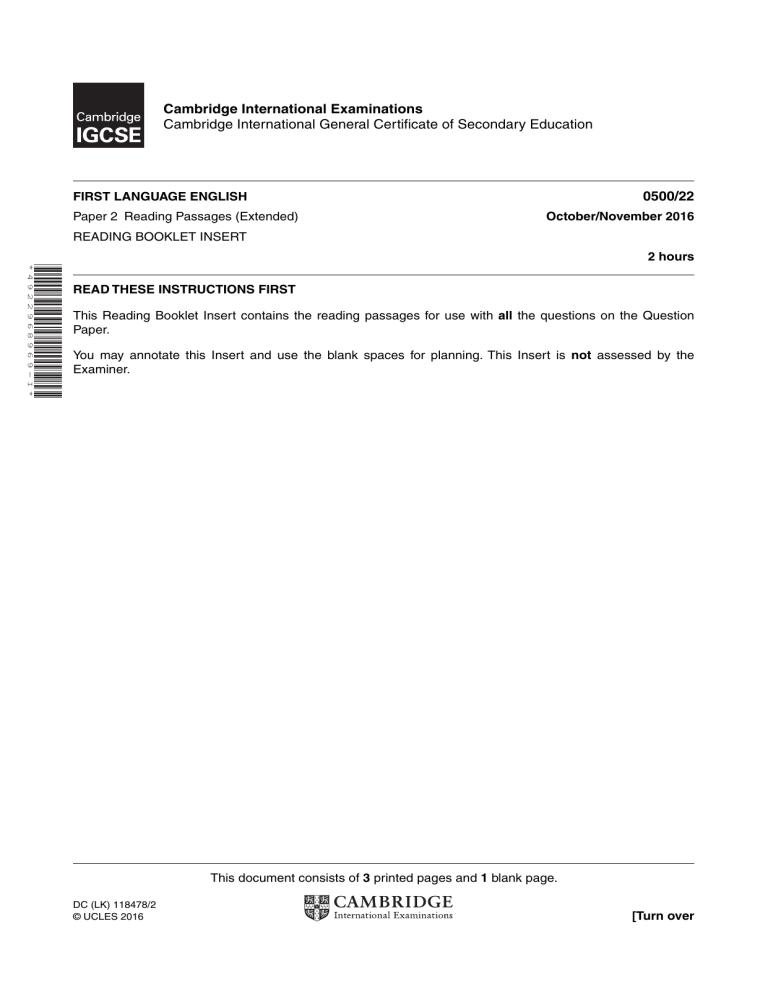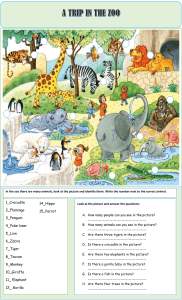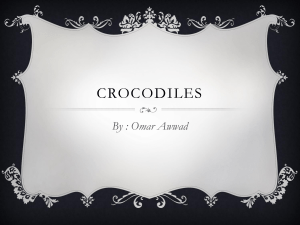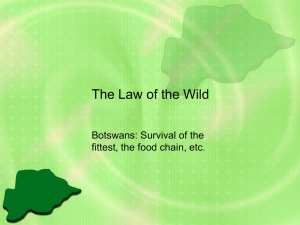
Cambridge International Examinations Cambridge International General Certificate of Secondary Education 0500/22 FIRST LANGUAGE ENGLISH Paper 2 Reading Passages (Extended) October/November 2016 READING BOOKLET INSERT 2 hours *4922968969-I* READ THESE INSTRUCTIONS FIRST This Reading Booklet Insert contains the reading passages for use with all the questions on the Question Paper. You may annotate this Insert and use the blank spaces for planning. This Insert is not assessed by the Examiner. This document consists of 3 printed pages and 1 blank page. DC (LK) 118478/2 © UCLES 2016 [Turn over 2 Part 1 Read Passage A carefully, and then answer Questions 1 and 2 on the Question Paper. Passage A: Crocodile Hunting Nick, a tourist, accompanies Jack Cox, a crocodile expert, on a night-time crocodile hunt in the swamps of New Guinea. Jack has assured him that in the swamps it is easier to see crocodiles at night. The sun disappeared below the horizon as we paddled further into the swamp. Now that we were free of the reeds, I found the balance of our canoe difficult to maintain. Its sides were high, but its draught was decidedly shallow, and the slightest movement tended to send the whole vessel lurching dangerously to one side. It wouldn’t have been my craft of choice for a crocodile hunt, especially without a life-jacket. My thoughts turned to the size of the specimens we might encounter. ‘It all depends on whether we come across salties or freshies,’ Jack told me. ‘The saltwater crocodile is massive. A mature male reaches a length of more than three metres, but really big ones can grow to twice that length.’ He was sweeping the beam of his powerful torch across the water in front of him. It sounded distinctly possible that we’d come across a considerably larger croc than I’d seen in the pen. Hearing Jack point it out in such a casual manner made my blood run cold. The nightmarish scene was not difficult to imagine: our monstrous aggressor would gobble us up with a sudden snap of its gigantic jaws and use the boat’s splinters as giant wooden toothpicks. I asked myself what I was doing on this hair-brained expedition, and failed to come up with a rational explanation. I asked Jack how he could tell the difference between a big crocodile and a small one. ‘Distance between the eyes,’ he murmured without interest. He was obviously concentrating hard on the sweeping beam in front of him. We glided along for some time, accompanied by the sound of frogs that resonated like castanets in the distance and the pneumatic buzzing of mosquitoes and other flying insects. I was being eaten alive and hadn’t been told I’d need repellent. The dark expanse of open water ahead of us was a floating wilderness of submerged, tangled tree roots, dotted with reeds and small shrubs sprouting above its surface. Jack continued scanning the murky waterline beneath the overhanging ferns before deciding to move on. We swept off into the darkness. A few moments later, Jack resumed his vigil with the torch. ‘There’s one,’ he whispered. I strained to follow the beam trained on the water, but couldn’t spot a thing. As we moved towards the crocodile, Jack whispered, ‘Lost him, it dived.’ We hung around the area for a while to see if the croc would resurface, but it didn’t, and we moved off again. ‘That’s a shame because it was a massive one,’ Jack said. I couldn’t tell whether he was being serious or just trying to scare me, but either way I wasn’t too unhappy to have missed it. We paddled for some time before Jack made an effort to scare me again. I’d been trying to get him to admit that what we were doing was dangerous. He denied it, but then he confessed that there was one situation that could be construed as risky. ‘If we come across a daddy croc, he might mistake our canoe for competition. The underside of a canoe looks fairly similar to another crocodile and if our croc felt like attacking, he’d have this boat over with one whip of his tail.’ I closed my eyes and shook my head, in the vain hope that this whole expedition would turn out to be a bad dream. But shaking my head was not a good idea, because it started the canoe rocking dangerously. I drew a deep breath: ‘OK Jack, if that did happen, and we ended up in the water, what should I do?’ Jack paused. ‘Well,’ he said, ‘don’t splash about because that will get him excited. Dive underwater and swim away. Crocs rarely bite underwater and he’s unlikely to follow you.’ I had noted that he’d said crocs rarely bite under water and that it was unlikely to follow me, but I didn’t pursue these points as the entire scenario was too horrible to imagine. I fell quiet, leaving Jack to continue scanning the water for swamp monsters while I digested this information. The whole escapade had been preposterous. If you choose to venture into a remote swamp in search of crocodiles, you might reasonably opt to do so with more equipment than a torch, a broom and a ball of twine. A gun might be handy for a start, and preferably a nippy boat with a large engine enabling a fast getaway. © UCLES 2016 0500/22/INSERT/O/N/16 3 Part 2 Read Passage B carefully, and then answer Question 3 on the Question Paper. Passage B: Crocodiles – How They’ve Survived Though the crocodile’s ancestry dates back 200 million years, crocodiles, as we know them today, first evolved about 80 million years ago. According to the fossil record, their body plan has changed little since, enabling them to outlive the dinosaurs and become the most advanced of all reptiles and the most successful freshwater predator. There is no single secret to the crocodile’s success. With few natural predators, a permanent armour of bony plates covering most of its body and strong jaw muscles capable of crushing anything from bones to cast iron, the crocodile is an extremely tough and robust creature. A croc can survive even after serious injuries such as a torn-off limb or tail and it has a powerful immune system that helps it survive for decades. But its adaptations go beyond being hardy. One of the keys to its survival is something one might think of as primitive: cold-bloodedness. Like all reptiles, crocodiles are ectotherms, which means they must gather heat from their environment. Crocodiles have developed behaviours to control their body thermostat: they bask in the sun when cool and seek shade or water when hot. Ectotherms like crocodiles don’t need to eat regularly to warm their bodies, and so they save an enormous amount of energy that can be put to other use or stored for later. A crocodile’s metabolism is so evolved that its body uses and stores nearly the entirety of the food it consumes. This is one reason why larger crocodiles can go for over a year without eating a meal. In extreme situations, crocodiles appear to be able to shut down and live off their own tissue for a long period of time. But most crocodiles eat much more often than that. In fact, on average they eat about 50 full meals a year. When they feast, crocodiles are certainly not picky eaters. It’s said that one will feed on anything it can outswim or ambush and overpower. These reptiles have extraordinarily adaptable diets. Larger crocodiles will eat larger mammals and birds, but they’ll also eat fish and molluscs like snails. During difficult times, they will even scavenge for carrion. In fact, crocodiles will consume almost everything they encounter. And that means everything. A crocodile’s stomach is the most acidic of all vertebrates, allowing it to digest bones, horns, hooves, or shells. Nothing gets left behind in a crocodile’s dinner. In fact these hard objects are used as ‘gizzard stones’ in the croc’s stomach to help grind coarse food. While the crocodile’s diet may be undiscriminating, its social interactions are a bit more complicated. Crocs are more social than all other reptiles. Though they primarily lead solitary lives, they resort to group behaviour for important activities such as hunting or raising hatchlings. Crocs don’t merely recognise one another; they form long-term relationships. They are hierarchical and communicate by means of vocalisation, postures, chemical signals, and even touch. A crocodile’s brain is more complex than that of any other reptile. These powerful predators also have an excellent sense of smell and superior sound perception. Noting the crocodile’s ability to learn to avoid dangerous situations, researchers have found that they have to modify their techniques when capturing them. It’s very hard to catch a crocodile twice with the same trick. Crocodiles have demonstrated behavioural, physiological and structural adaptations that have allowed them to thrive for hundreds of millions of years, but unfortunately, surviving human encroachment may be their biggest challenge ever. Through habitat enhancement and environmental education, humans may be able to ensure that these once-endangered, prehistoric reptiles practise their sophisticated survival skills for years to come. © UCLES 2016 0500/22/INSERT/O/N/16 4 BLANK PAGE Permission to reproduce items where third-party owned material protected by copyright is included has been sought and cleared where possible. Every reasonable effort has been made by the publisher (UCLES) to trace copyright holders, but if any items requiring clearance have unwittingly been included, the publisher will be pleased to make amends at the earliest possible opportunity. To avoid the issue of disclosure of answer-related information to candidates, all copyright acknowledgements are reproduced online in the Cambridge International Examinations Copyright Acknowledgements Booklet. This is produced for each series of examinations and is freely available to download at www.cie.org.uk after the live examination series. Cambridge International Examinations is part of the Cambridge Assessment Group. Cambridge Assessment is the brand name of University of Cambridge Local Examinations Syndicate (UCLES), which is itself a department of the University of Cambridge. © UCLES 2016 0500/22/INSERT/O/N/16



